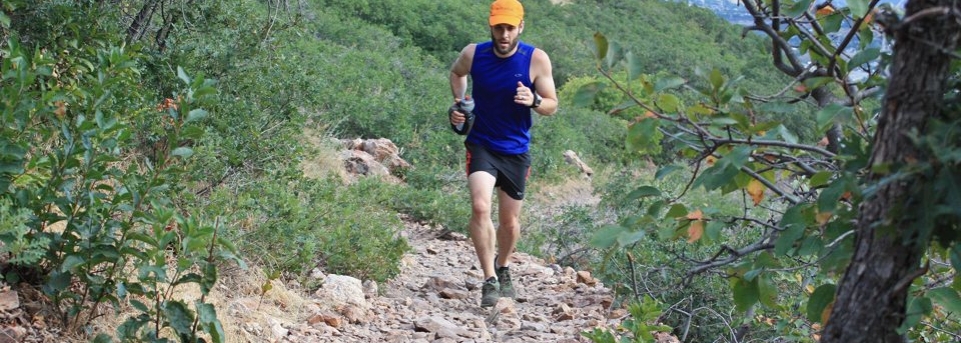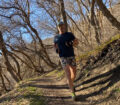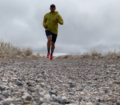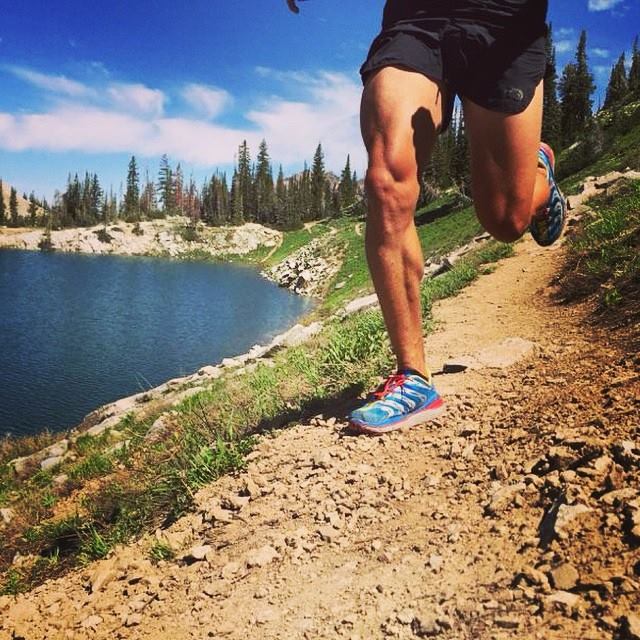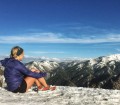In my last article I talked about what to expect when you transition from the road to the trail. Things that seem like common sense but create big ‘ah ha’ moments once you experience them. These include rocks, roots, hills, water & mud, animals, injuries, less speed and the payoff of nature’s beauty and a sense of community with fellow runners. In this article I want to tackle one of the most basic things you’re gonna deal with on the trail…Rocks.
First, let’s start with the Golden Rule of trail running… if your head goes up, you’ll go down. You’ve got to watch where you’re running at all times. Initially, you need to concentrate on the trail and what’s coming at you. You’ll be looking at the trail, what’s coming up and consciously thinking about your movements and steps. As your experience grows you’ll find that the eyes see, the brain processes and the body reacts without as much concentration. The Golden Rule still holds true though and the eyes have to see, so keep your head looking at the trail approximately 15 to 20 feet in front of you.
Now that we’ve got you looking let’s talk about these Rocks. Last time I mentioned that rocks come in all shapes and sizes and are the meat and potatoes when it comes to the challenge of trail running. The “all shapes and sizes” comment could not be truer. Let’s break it down in terms of size and mentioned the features, challenges and adaptions for each.
1. Pea gravel to golf ball size rock. This can can some of the toughest stuff to run on for a number of reasons. First, pea gravel likes to find it’s way into your shoes. And, I make the comment of pea gravel like it’s all round; most certainly it is not. There’s always one pyramid shaped rock that likes to find it’s way into my shoe and implants itself either under my heel or forefoot. Normally, you try to keep running and hopefully work the rock between your toes or somewhere harmless because no one wants to stop and deal with these things. The best way to keep stuff out is by wearing gaiters. Dirty Girl gaiters are inexpensive, lightweight and the choice of most trail runners. As for actually running on these rocks, it all depends on their density. If there’s enough of it on a steep downhill then you’re gonna be sliding and surfing down it. Get used to breaking loose; it happens. Your inclination is to lean backwards but this really accelerates the slipping because by leaning back you are braking. It’s like stopping on ice. The more you brake the more you slide. The best way to handle downhill loose gravel is to flow with it if you can. If you need to slow down then try to maintain and upright position, use your arms for balance and keep your feet in a good athletic position about shoulder width apart. If you run into thick gravel on a flat or uphill surface you’ll certainly get less push off for your effort and this can be exhausting. Most of the time though it’s not dense enough to effect your running.
Tips
A. Invest in gaiters
B. Watch where you’re going
C. Roll with it on the downhills.
[Continued Below]
[tabs slidertype=”images” auto=”yes” autospeed=”4000″][imagetab width=”558″ height=”372″]http://trailandultrarunning.com/wp-content/uploads/2013/09/trail-running-rocks-6.jpg[/imagetab][imagetab width=”558″ height=”372″]http://trailandultrarunning.com/wp-content/uploads/2013/09/trail-running-rocks-5.jpg[/imagetab][imagetab width=”558″ height=”372″]http://trailandultrarunning.com/wp-content/uploads/2013/09/trail-running-rocks-7.jpg[/imagetab][imagetab width=”558″ height=”372″]http://trailandultrarunning.com/wp-content/uploads/2013/09/trail-running-rocks-4.jpg[/imagetab][imagetab width=”558″ height=”372″]http://trailandultrarunning.com/wp-content/uploads/2013/09/trail-running-rocks-3.jpg[/imagetab][imagetab width=”558″ height=”372″]http://trailandultrarunning.com/wp-content/uploads/2013/09/trail-running-rocks-2.jpg[/imagetab][imagetab width=”558″ height=”372″]http://trailandultrarunning.com/wp-content/uploads/2013/09/trail-running-rocks-1.jpg[/imagetab][imagetab width=”558″ height=”372″]http://trailandultrarunning.com/wp-content/uploads/2013/09/trail-running-rocks-.jpg[/imagetab][imagetab width=”558″ height=”372″]http://trailandultrarunning.com/wp-content/uploads/2013/09/trail-running-rocks-utah-3.jpg[/imagetab][imagetab width=”558″ height=”372″]http://trailandultrarunning.com/wp-content/uploads/2013/09/trail-running-rocks-utah-2.jpg[/imagetab][imagetab width=”558″ height=”372″]http://trailandultrarunning.com/wp-content/uploads/2013/09/trail-running-rocks-utah-1.jpg[/imagetab][/tabs]
2. Golf ball to large potato rock. Again, think all shapes and sizes. This stuff ought to be called sprained ankle size rock. Whether loose or embedded it’s dangerous. If it’s embedded in the ground then it’s just the tip of an iceberg; hence, it’s firmly planted so kicking it or landing on top of it means your body loses the battle.
Loose and densely packed, like a dry creek bed, and you shouldn’t have much trouble. Loose and on a hill, this size rock is dangerous in many ways. You’ll kick them, ouch. Sometimes you kick them into your own ankle, double ouch. And, on really steep hills you can kick one, have it bounce off your ankle then watch it trundle down at a person below you, triple ouch. Again, you may be thinking round but they can have very sharp edges. Lots of very sharp edges rock on the side of a hill, or mountain, is called a scree field. Finally when it’s loose and on flat surfaces, you’ve got to be really careful. This is where you can severely twist an ankle.
Tips
A. Keep you head down, stop talking and process.
B. Slow down
3. Potato to the beach ball. Densely packed with sharper edges and you have what’s called a talus field. Talus fields require a light dance and extreme concentration if you even attempt to run. Most often you’ll carefully power hike. When these rocks are not densely concentrated, but embedded into the ground, then you end up with an obstacle course. It can be run in two ways; you can run to miss the rocks or incorporate them into your landing and push off. Experiment and find your own style. You “generally” won’t find is these size rocks just laying around loose in the middle of the trails. Trail maintenance moves most of these aside.
Tips
A. Extreme focus
B. Power hiking recommended
C. No talking and head down
4. Bigger than a beach ball equals a boulder. These “rocks” can get bigger than VW bug. They really don’t move so it’s a matter of hopping, scaling or climbing across them. If they’re large enough to climb and the face is vertical then remember to keep 3 points of contact all all times. Otherwise, just enjoying the scrambling.
Tip
A. 3 Points of contact on severe faces
Despite the potential downfalls (sometimes literal!) of running among these ever present rocks, careful practice and application of proper focus and footwork can be immensely satisfying. Start off nice and easy and work your way up until running through the rocks, rocks!

